Strawberries
Mite Meeting Planned for May 30 in Salinas
UC Cooperative Extension Farm Advisors Shimat Joseph, Surendra Dara and Mark Bolda are holding a mite meeting in Spanish and English at the ALBA training facility at 1700 Old Stage Road in Salinas. All aspects of mite management will be covered, from proper identification of predatory, twospotted spider and Lewis mites, treatment thresholds, use of botanical and botanical controls, and aspects of chemical, cultural and biological control.
Meeting starts at 9 and will wrap up by 11 am. This promises to be a very good meeting.
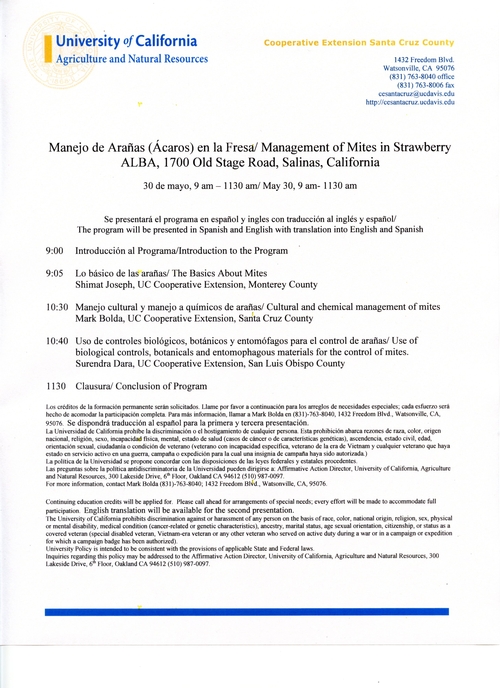
Spanish/English meeting on mites planned for May 30 at ALBA in Salinas.
LBAM Larvae Found in Fields - USDA /CDFA Regulatory Effort in Full Swing
Yes, light brown apple moth (LBAM) are being found in both conventional and organic berry fields right now, so please growers and field people be taking care to keep them out. A field closure is not pleasant for anybody involved, so do all you can to keep this pest out - pheromone based twist ties, sprays and yes even physical removal of rolls.
I've included the current USDA - CDFA protocol provided to me by Laura Irons, Senior Environmental Scientist with the CDFA, for approved sprays. Note the length of time between the regulated spray of most of the materials and the time that inspectors come back - it's from 10 to even 20 days, which is a heck of a long time to be out of the market. PLEASE do all you can to keep LBAM out of your fields.
I've also added the link to the USDA/CDFA LBAM inspection protocol at coolers, processors and packing facilities. It hasn't changed from the past seasons, but it's worth a review as our production year heats up.
//ucanr.edu/blogs/strawberries_caneberries/blogfiles/7341.pdf
LBAMApprovedTreatments (2)
Day of Science and Service for UCCE Centennial
To my readers:
Tomorrow is the 100th birthday of UC Cooperative Extension in California. It's been an honor for me to take part in 12 of those 100 years and what a long, interesting and productive journey this has been so far!
You are all invited to our open house tomorrow at the UCCE Santa Cruz County office in Watsonville on 1432 Freedom Blvd from 3 to 6 pm.
Also, even if you can't make it out to our open house, try and participate in our Day of Science and Service. There are three different exercises in the link below, but try out the pollinator counting. This is a pretty neat exercise, where each of you counts pollinators - don't forget, bees aren't the only ones pollinating- for three minutes.
Try it out - and remember to wish UCCE Happy 100th Birthday tomorrow!
http://100.ucanr.edu/Day_of_Science_and_Service/
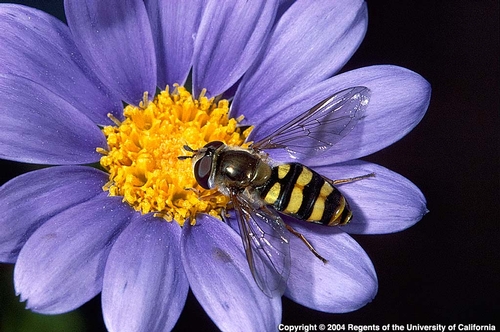
Syrphid fly on flower - yes these are also pollinators! Count them tomorrow for three minutes as part of UCCE's Day of Science and Service.
Intrepid 2F Now Labeled for Use in Caneberries
Intrepid 2F is now labeled for use on lepidopterous pests in caneberries. It's a very good material, we managed to take some of the tailwinds generated by the LBAM storm to get this one through quicker. It's good to have a local Farm Advisor around for these types of things isn't it?
Caneberry label attached below.
Intrepid caneberry
Unusual Flare-up of Leaf Blotch Disease of Strawberry
Leaf blotch disease, caused by Zythia fragariae, is a very minor foliar disease of strawberry in California. Usually the disease occurs in late winter/early spring when there are sufficient rains to activate the fungus and spread the spores. Once the winter season rains have ceased, the disease subsides before the development of much fruit. Because of the drought, leaf blotch was generally not observed or reported during the late winter/early spring of this season.
However, an unusual flare-up of leaf blotch is currently developing in some fields in the central coast. Because of the lack of rainfall and build up of salts in the soil, some growers used sprinklers in the early spring to alleviate salt buildup and reduce subsequent stress of the strawberry transplants. It appears that in some cases, the sprinkler irrigations have enabled Zythia to develop and cause typical leaf blotches. Symptoms consist of tan to gray leaf lesions that commonly (though not exclusively) develop along the margin or edge of the leaflets (Photo 1). Leaf blotches are irregular in shape and may be surrounded by a purple border. These affected areas tend to grow fairly large; they can expand and cover from 1/4 to 1/2 of the leaflet surface. A key diagnostic feature of leaf blotch is the presence of tiny, brown to black, fungal fruiting bodies in the gray blotches (Photos 2 and 3). These fruiting bodies produce tiny spores (Photo 4) that are readily spread by splashing water.
A related development is the formation of brown to tan lesions on the calyx tissue of strawberry fruit (Photo 5). Calyx lesions appear to be associated with plants having the leaf symptoms. In some cases, the Zythia fruiting bodies are present in the calyx lesions and appear as darker brown, circular to oblong structures (Photo 6). However, fruiting bodies are not always present; since there are other physiological or environmental factors that can result in damage to fruit calices, care should be taken when diagnosing this problem.
UC Cooperative Extension does not have efficacy data for fungicide use for leaf blotch; therefore, we do not recommend or suggest the use of fungicides. Researchers in other areas (Europe) have determined that the following materials have good effectiveness against the leaf blotch pathogen: Pristine, Quadris, Rally. Switch also reduced disease but was less effective. This April occurrence of leaf blotch following sprinkler irrigations is a good reminder of how environmental conditions are essential for the development of plant diseases. This leaf blotch situation may continue to be present if any late April rains fall.
There are fungicides mentioned for management of leaf blotch disease in this article. As always, before using any of these products, check with your local Agricultural Commissioner's Office and consult product labels for current status of product registration, restrictions, and use information.
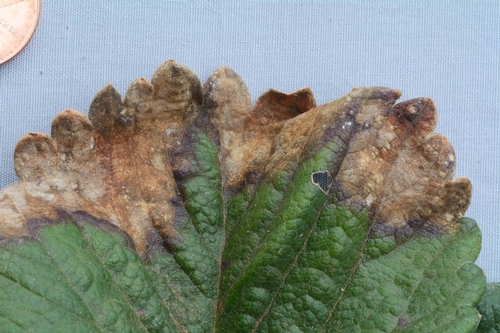
Photo 1. Leaf blotch is characterized by irregularly shaped, gray to brown leaf lesions. Photo: Steven Koike, UCCE.
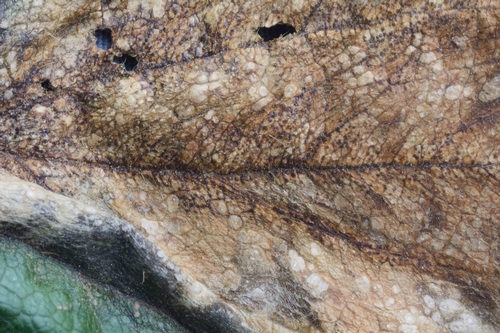
Photo 2. Fungal fruiting bodies are usually present in the leaf blotch lesions. Photo: Steven Koike, UCCE.
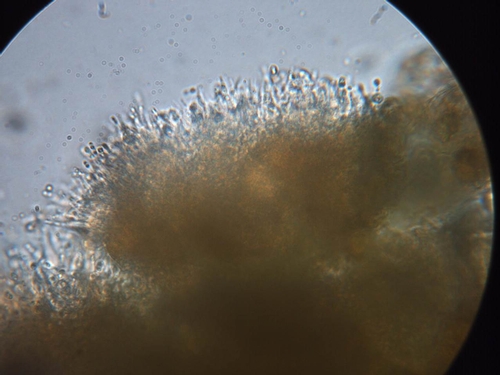
Photo 3. Close up photograph of a portion of the Zythia fruiting body; each upright spike produces an infective spore. Photo: Steven Koike, UCCE.
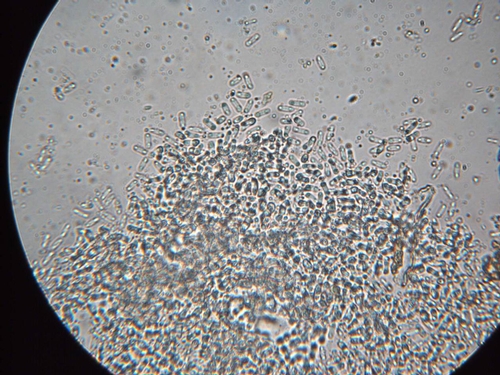
Photo 4. Zythia produces tiny spores that are spread by splashing water. Photo: Steven Koike, UCCE.
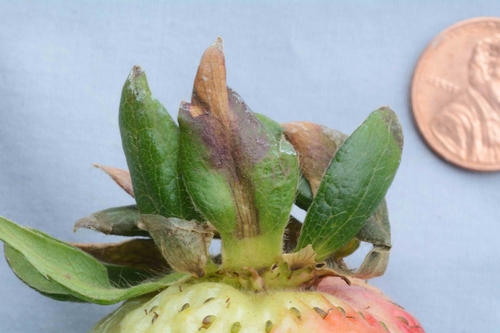
Photo 5. In some cases, it appears that Zythia is causing lesions on fruit calyx tissue. Photo: Steven Koike, UCCE.
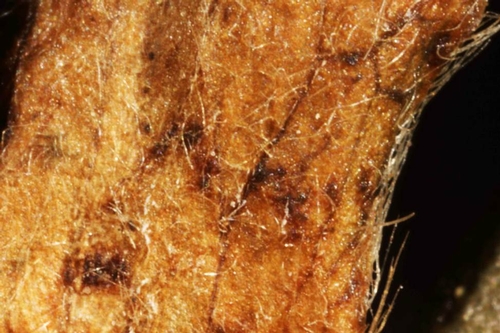
Photo 6. Fruiting bodies in strawberry calyx tissues confirm the presence of Zythia. Photo: Steven Koike, UCCE.

